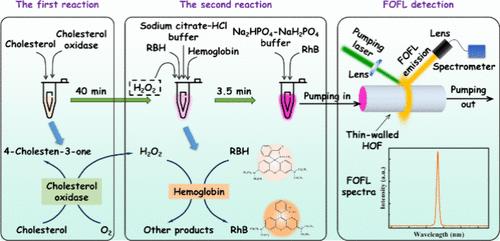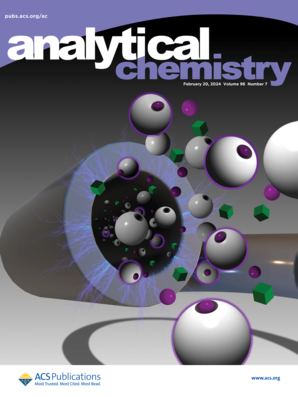An Enzyme-Catalyzed Optical Fiber Optofluidic Laser Sensor for Cholesterol Detection Using Rhodamine B Hydrazide
IF 6.7
1区 化学
Q1 CHEMISTRY, ANALYTICAL
引用次数: 0
Abstract
A method for the determination of cholesterol using rhodamine derivatives as chromogenic substrates was proposed in this study. The oxidation of rhodamine B hydrazide (RBH) by hydrogen peroxide (H2O2) was catalyzed by a peroxide-mimicking enzyme to produce the fluorescent product. The reaction was further combined with the oxidase system to achieve indirect determination of cholesterol concentration, which can be catalyzed by cholesterol oxidase to produce H2O2 as an intermediate product. Optical fiber optofluidic lasers (FOFLs), as a sensitive biochemical detection platform, have the ability to distinguish small differences in the amount of fluorescence products generated by the reaction and were used to achieve sensitive cholesterol detection. Under optimized experimental conditions, the dynamic range of three orders of magnitude was obtained in the determination of H2O2 with a lower limit of detection (LOD) of 1.63 μM, and the assay time was as short as 3.5 min. On this basis, the designed cholesterol sensor obtained a linear range of 2.55–652.67 μM with a lower LOD of 2.55 μM and proved to have good selectivity. The possibility of cholesterol determination in human serum was initially tested. The sensor was also characterized by easy signal collection, wash-free procedure, controlled sample consumption, fast assay, low cost, and simple operation.

求助全文
约1分钟内获得全文
求助全文
来源期刊

Analytical Chemistry
化学-分析化学
CiteScore
12.10
自引率
12.20%
发文量
1949
审稿时长
1.4 months
期刊介绍:
Analytical Chemistry, a peer-reviewed research journal, focuses on disseminating new and original knowledge across all branches of analytical chemistry. Fundamental articles may explore general principles of chemical measurement science and need not directly address existing or potential analytical methodology. They can be entirely theoretical or report experimental results. Contributions may cover various phases of analytical operations, including sampling, bioanalysis, electrochemistry, mass spectrometry, microscale and nanoscale systems, environmental analysis, separations, spectroscopy, chemical reactions and selectivity, instrumentation, imaging, surface analysis, and data processing. Papers discussing known analytical methods should present a significant, original application of the method, a notable improvement, or results on an important analyte.
 求助内容:
求助内容: 应助结果提醒方式:
应助结果提醒方式:


